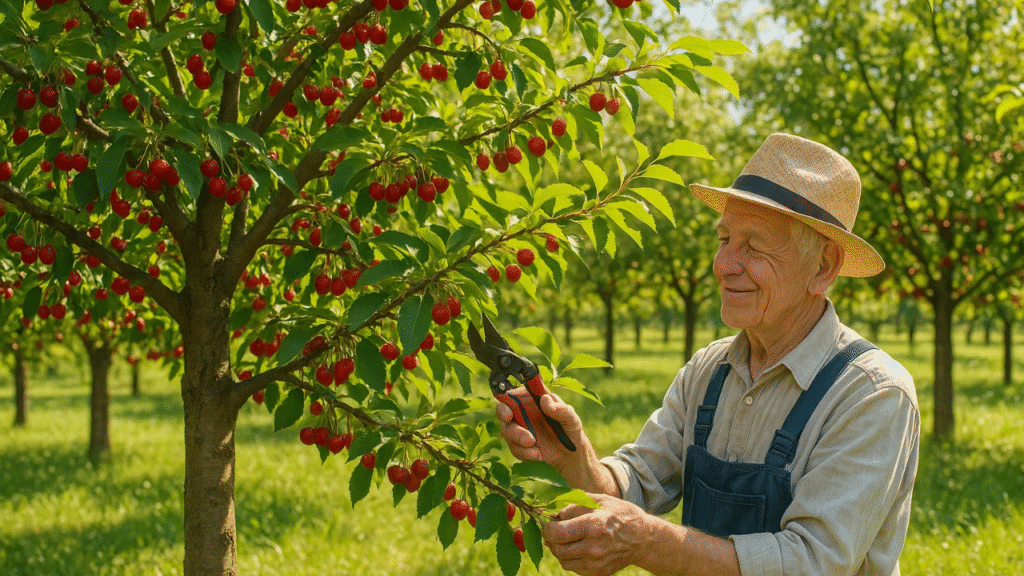
Cherry Tree Pruning: When and How to Cut for Maximum Yield and Healthy Growth
Cherry tree pruning is more than just a gardening chore—it’s the key to unlocking a healthier, more productive tree 🍒. If you’ve ever wondered when and how to prune your cherry tree to achieve the best yield, you’re in the right place! 🌳 Proper pruning not only boosts your tree’s overall health but also enhances fruit production, helping you harvest bigger, juicier cherries. In this guide, we’ll walk you through the essential steps of Cherry Tree Pruning: When and How to Cut for Maximum Yield, so you can give your tree the care it deserves for a bountiful season ahead. Let’s get started!
Table of Contents
Toggle🌳🍒 Why Pruning Is Important for Cherry Trees 🍒🌳
Pruning is a vital part of cherry tree care, offering several benefits that directly contribute to the health and productivity of your tree:
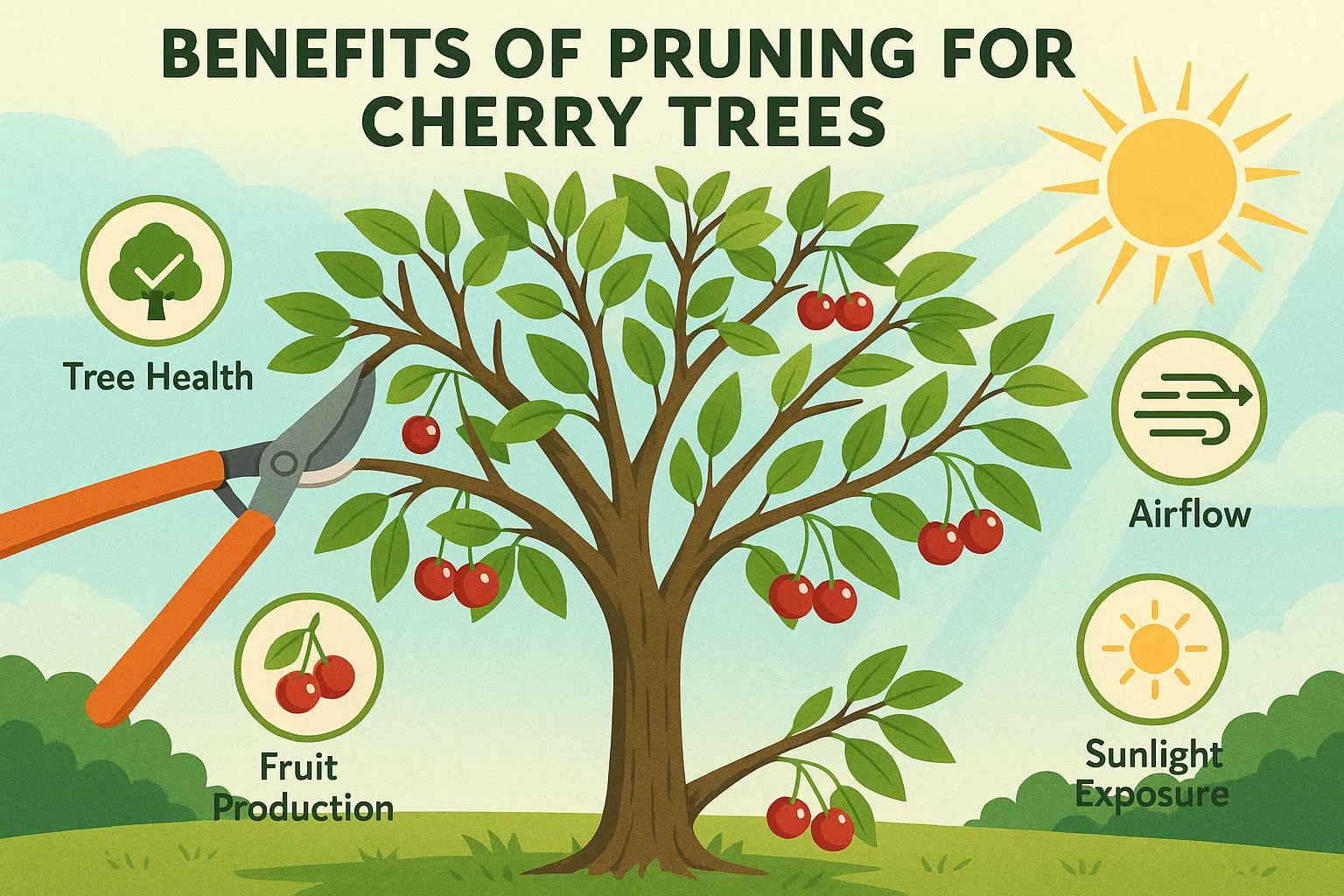
- Enhances Tree Health 🏥: Removing dead, diseased, or damaged branches helps prevent the spread of pests and diseases, allowing your cherry tree to stay strong and free of infections.
- Improves Airflow and Sunlight Exposure ☀️: Proper pruning creates space within the tree, allowing better air circulation and sunlight to reach all branches. This reduces fungal growth and encourages healthier foliage.
- Increases Fruit Production 🍒: Pruning encourages the development of strong, productive branches that can support more fruit, leading to a higher yield of larger, juicier cherries.
- Promotes a Strong Structure ✂️: Regular pruning shapes the tree and keeps it balanced, preventing overgrowth and making it easier to manage. A well-pruned tree is more stable and better able to handle heavy fruit loads.
In short, pruning isn’t just about cutting branches—it’s about creating the ideal environment for your cherry tree to thrive and produce the best possible harvest! Mastering cherry tree pruning: when and how to cut for maximum yield will help you achieve healthier growth and more abundant fruit.
🌸🍒 When to Prune Cherry Trees 🍒🌸
Timing plays a crucial role in the health and success of your cherry tree. Pruning at the right moment can improve growth and yield, while pruning at the wrong time can stress the tree. Here’s when to prune:
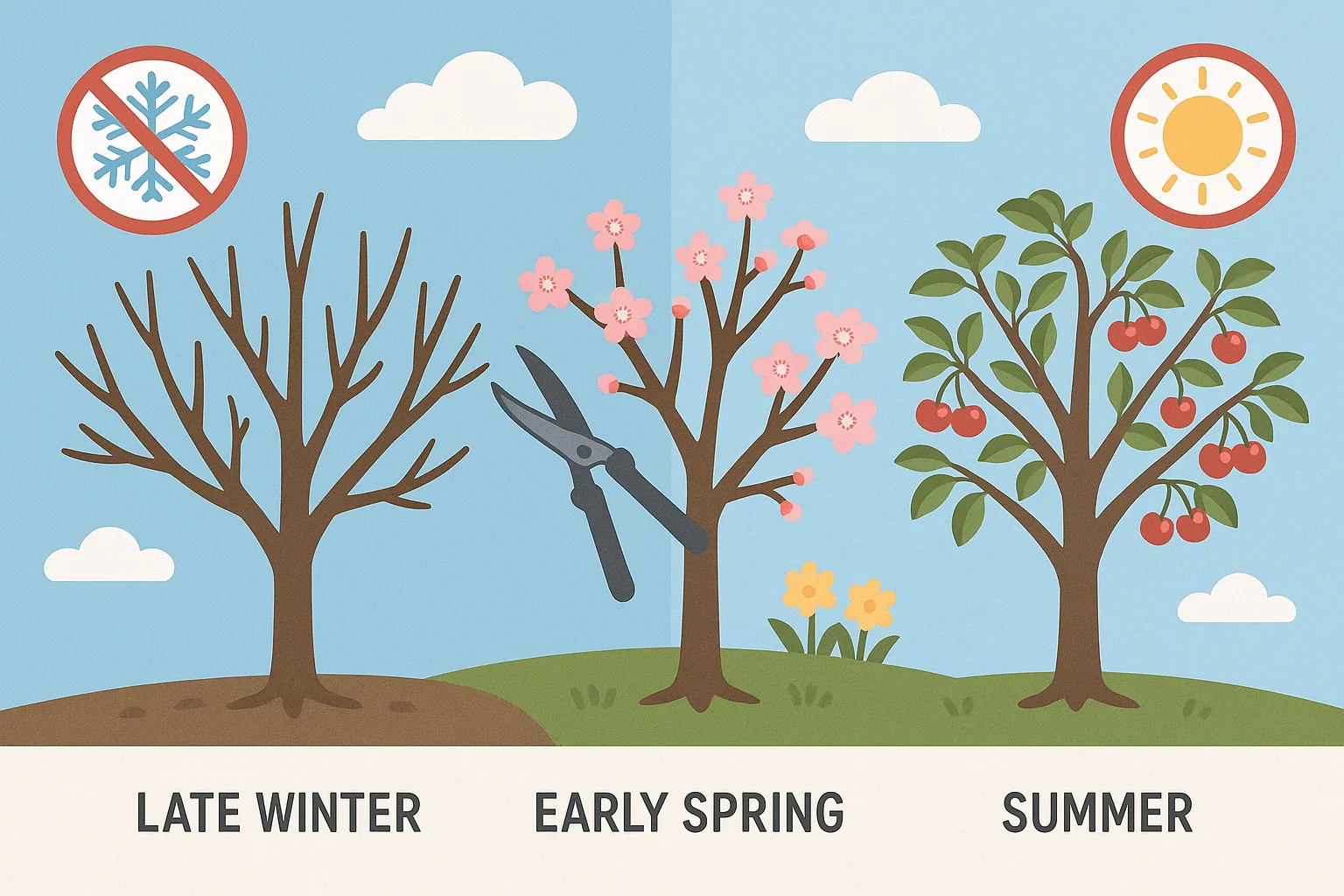
- Best Time: Late Winter to Early Spring ❄️➡️🌱: The best time to prune cherry trees is when they are still dormant, just before new growth starts in early spring. This is usually in late winter or early spring. Pruning during this time minimizes stress, helps the tree heal quickly, and reduces the risk of disease.
- Avoid Late Fall or Winter Pruning 🌨️: Pruning too late in the season, especially right before or during frosty weather, can leave the tree vulnerable to damage. The cuts may not heal properly, and the tree could struggle to recover.
- Prune After Harvest for Overgrown Trees 🍒🌳: If your tree is mature or overgrown, prune it after the harvest to shape and control its size. This gives the tree time to rest before the next growth cycle begins.
Pruning at the right time helps your cherry tree stay strong and ensures better health and fruit production throughout the year.
✂️🛠️ Tools You’ll Need for Pruning 🛠️✂️
Having the right tools is essential for effective and safe cherry tree pruning. Here’s a list of the basics you’ll need:
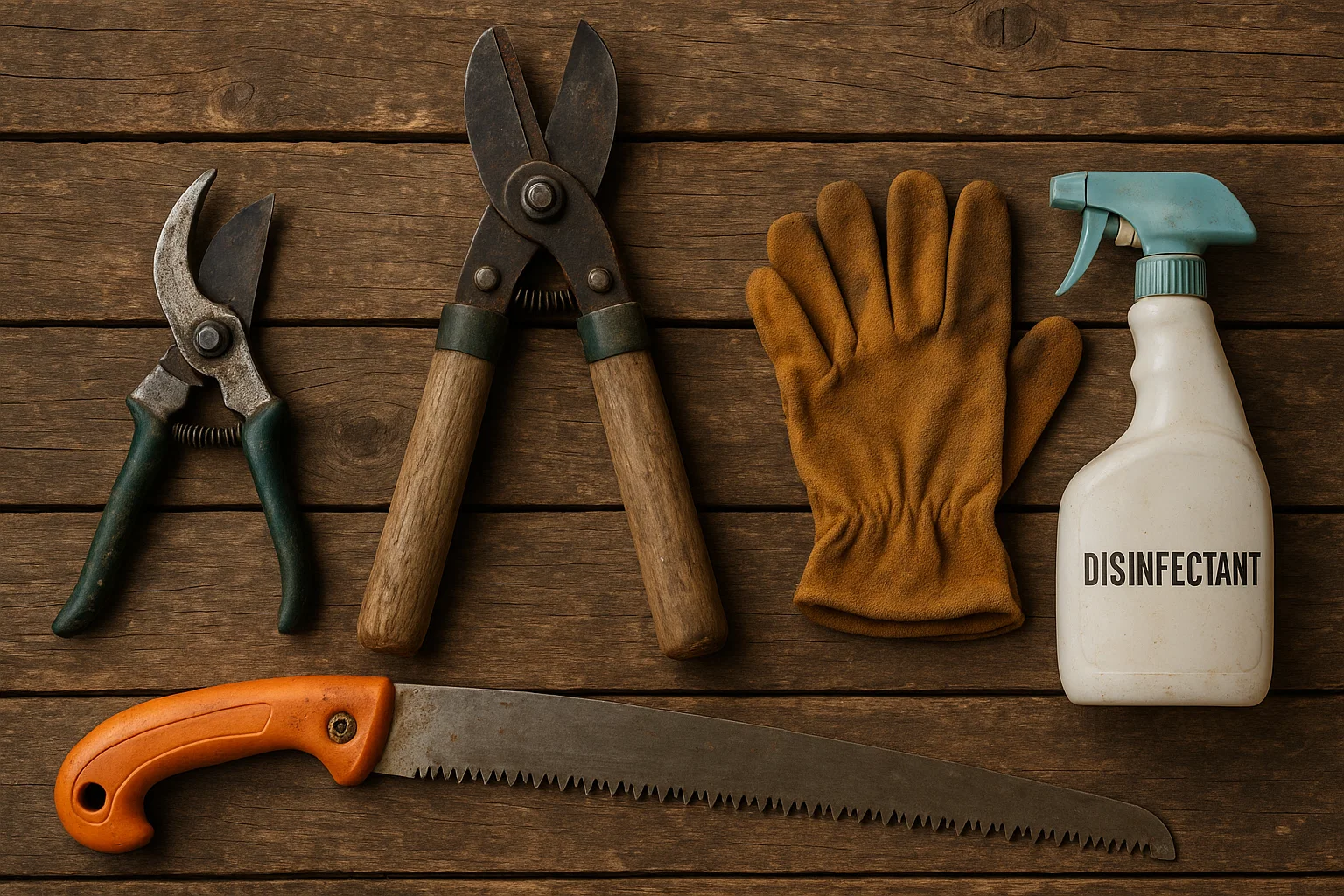
- Pruning Shears ✂️: Ideal for cutting small, thin branches (less than ¾ inch in diameter). A sharp pair will make clean cuts and prevent damaging the tree.
- Loppers 🌿: These are perfect for slightly thicker branches (up to 1 ½ inches). Loppers give you more leverage for making precise cuts without straining.
- Pruning Saw 🪚: For larger branches (more than 1 ½ inches). A pruning saw is especially useful for removing heavy, woody limbs that can’t be handled by shears or loppers.
- Gloves and Protective Gear 🧤: Protect your hands from thorns, rough bark, and potential injuries while working with sharp tools.
- Disinfectant 🧴: Clean your tools between cuts to avoid spreading diseases from one branch to another. A simple disinfectant like rubbing alcohol will do the job.
- Optional: Pole Pruner 🪶: If you need to reach high branches, a pole pruner will help you safely trim without needing a ladder.
Using the right tools ensures that your pruning is safe, efficient, and clean—ultimately helping your cherry tree stay healthy and productive! To get the best results, it’s important to understand Cherry Tree Pruning: When and How to Cut for Maximum Yield.
🌳✂️ How to Prune a Cherry Tree (Step-by-Step Guide) ✂️🌳
Pruning your cherry tree doesn’t have to be complicated. By following this step-by-step guide, you can ensure your tree stays healthy, productive, and beautifully shaped. Here’s how to do it:
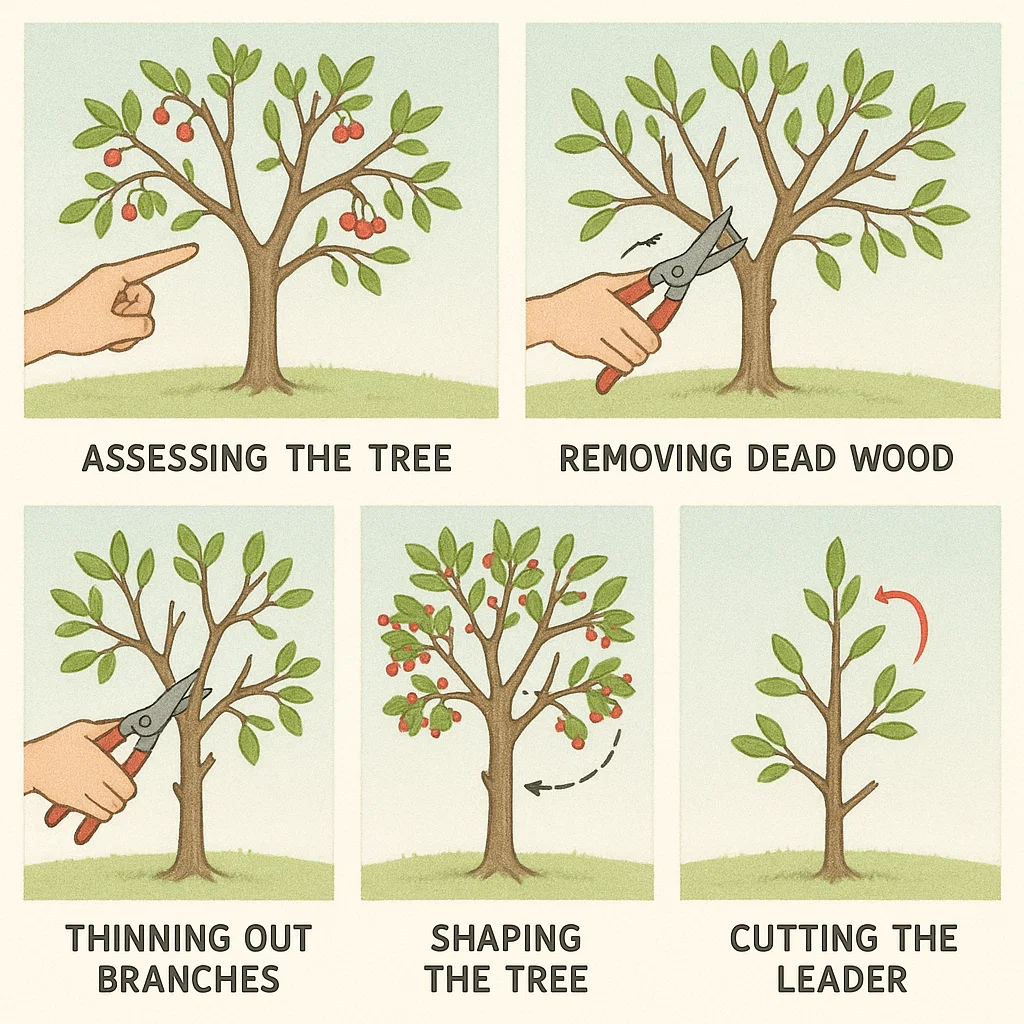
👀 Step 1: Assess the Tree’s Health and Shape 👀
Before you start cutting, take a good look at your tree. Identify any dead, damaged, or diseased branches. These will need to be removed first, as they can harm the tree or spread disease. Also, look for any branches that are growing inward, crossing each other, or crowding the center. These can hinder airflow and block sunlight.
🏥 Step 2: Remove Dead, Damaged, or Diseased Wood 🏥
Start by cutting out any dead, diseased, or damaged wood. These branches are not only unproductive but also a source of potential disease and pests. Make sure to cut back to healthy tissue. If the branch is diseased, sterilize your pruning tools before moving to the next cut to avoid spreading the infection.
🍃 Step 3: Thin Out the Tree for Better Airflow 🍃
Now that you’ve removed unhealthy branches, it’s time to thin out the canopy. Look for areas where branches are overcrowded or crossing each other. These areas can restrict airflow and sunlight, which are essential for healthy growth and fruiting. Remove the weaker branches to allow for better air circulation, and make sure to leave enough space between branches for light to penetrate the center of the tree.
✂️ Step 4: Shape the Tree for Strength and Structure ✂️
Pruning isn’t just about cutting—it’s about shaping the tree for long-term health. For a cherry tree, a strong central leader (the main vertical trunk) is key. Keep 3-4 main branches radiating out from the central leader, which will help your tree maintain a stable structure. If you have too many competing branches, remove the weaker ones. Ensure the tree has an open, balanced shape, which will support better fruit production.
🌱 Step 5: Cut the Leader (For Young Trees) 🌱
If you’re working with a young cherry tree, consider cutting the central leader back by about a third. This will encourage lateral (side) growth, which is important for developing a strong framework of branches. A good leader helps the tree grow upward while still producing a well-balanced structure. Avoid cutting too much—just a gentle trim to promote growth in the right direction.
🌿 Step 6: Remove Suckers and Water Sprouts 🌿
Suckers (small shoots growing from the base) and water sprouts (vigorous shoots that grow vertically) can drain energy from your tree. These are unproductive and can lead to poor growth, so be sure to cut them off at the base. Regularly removing these ensures your tree focuses its energy on growing strong fruiting branches.
🎯 Step 7: Final Touches and Clean-Up 🎯
Once you’ve completed the main pruning, go over the tree again to ensure you’ve removed any small, unnecessary branches or leftover suckers. Make sure all cuts are clean and smooth. If you’ve cut larger branches, use a pruning sealant to protect the wounds from pests and disease, especially if your tree is susceptible to infections.
🧴 Step 8: Clean and Sterilize Tools 🧴
After pruning, it’s essential to clean your tools to avoid spreading diseases. Use rubbing alcohol or a disinfectant to wipe down your shears, loppers, and saws.
By following these steps, your cherry tree will grow stronger, healthier, and more productive. Pruning is an ongoing process that requires attention, but with these simple steps, you’ll help your tree thrive for years to come! 🌳🍒 Learning the essentials of Cherry Tree Pruning: When and How to Cut for Maximum Yield ensures you get the best results each season.
✂️🍒 Tips for Pruning Cherry Trees 🍒✂️
Pruning your cherry tree can be a rewarding experience when done right. Here are some practical tips to ensure your tree stays healthy and productive throughout the years:
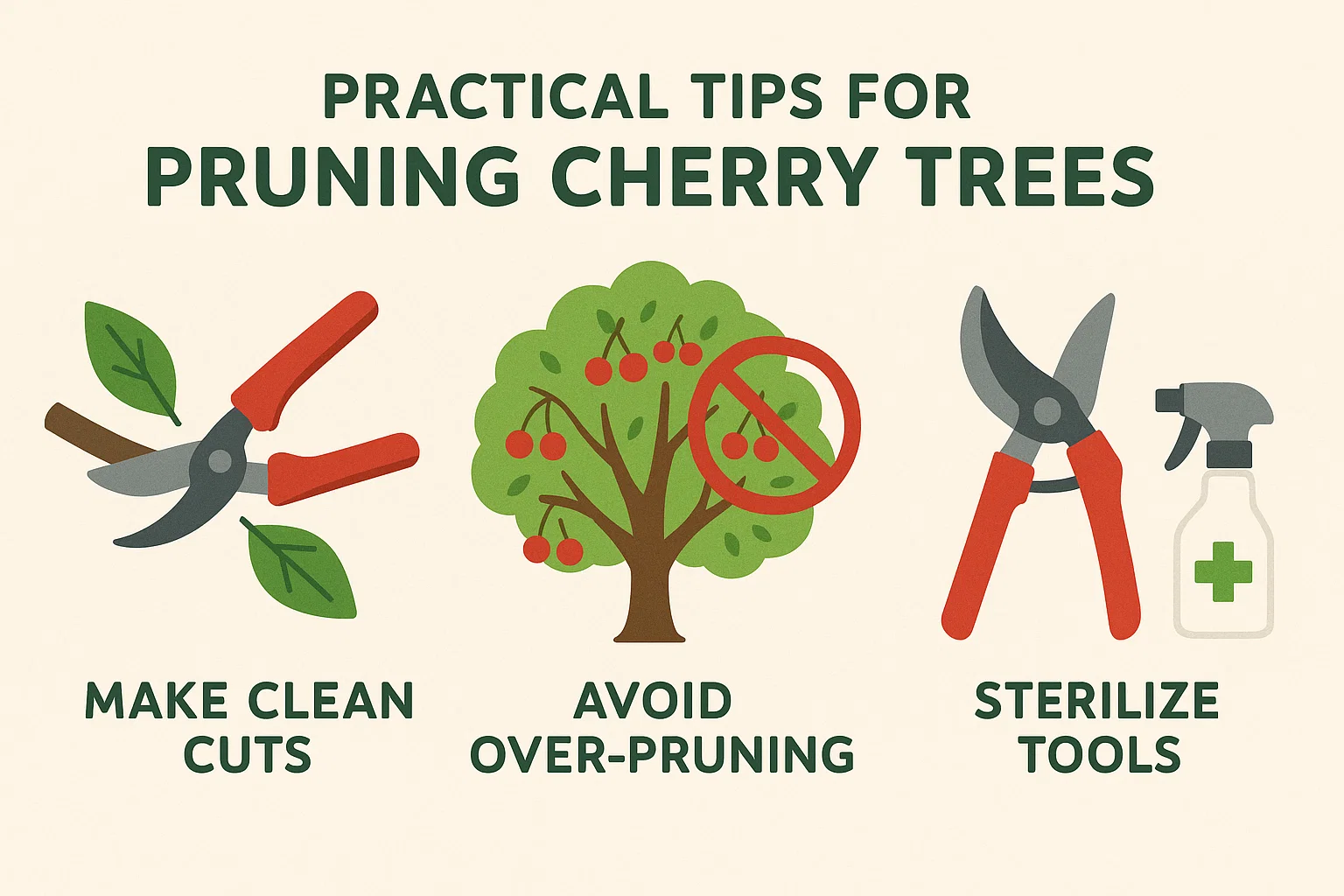
✂️ Make Clean Cuts ✂️
Always aim for clean, smooth cuts to promote quicker healing. Jagged cuts can create openings for diseases and pests to enter. Use sharp tools for the best results.
🧠 Prune Slowly and Thoughtfully 🧠
Take your time to assess the tree before making any cuts. A thoughtful approach will help you make better decisions about which branches to remove. Don’t rush the process!
❌ Don’t Over-Prune ❌
While it’s important to remove dead or unhealthy branches, over-pruning can stress your tree. Limit pruning to 20-30% of the tree’s total growth to ensure you’re not taking away too much.
🌳 Focus on the Tree’s Structure 🌳
When pruning, prioritize the tree’s natural structure. Keep the central leader intact (if it’s a young tree) and encourage lateral growth. This ensures the tree has a strong and balanced framework that can support heavy fruit.
🌱 Prune for Future Growth 🌱
Always think ahead! Trim branches that may hinder future growth, but also leave space for the tree to expand. This will help you avoid problems down the road.
🔄 Prune Regularly 🔄
Regular maintenance is key to keeping your tree healthy. Annual pruning, especially in the early spring, will help your tree maintain its shape and continue producing quality fruit year after year.
🧴 Sterilize Your Tools 🧴
After every cut, disinfect your tools, especially when cutting diseased branches. This prevents the spread of disease to other parts of the tree or to other trees in your garden.
By following these simple tips, you’ll help your cherry tree grow strong, produce bountiful fruit, and stay healthy for years to come! 🌳🍒
🚨✂️ Signs You’ve Pruned Too Much ✂️🚨
While pruning is important, it’s easy to overdo it, which can stress your cherry tree. Here are some signs that you may have pruned too much:
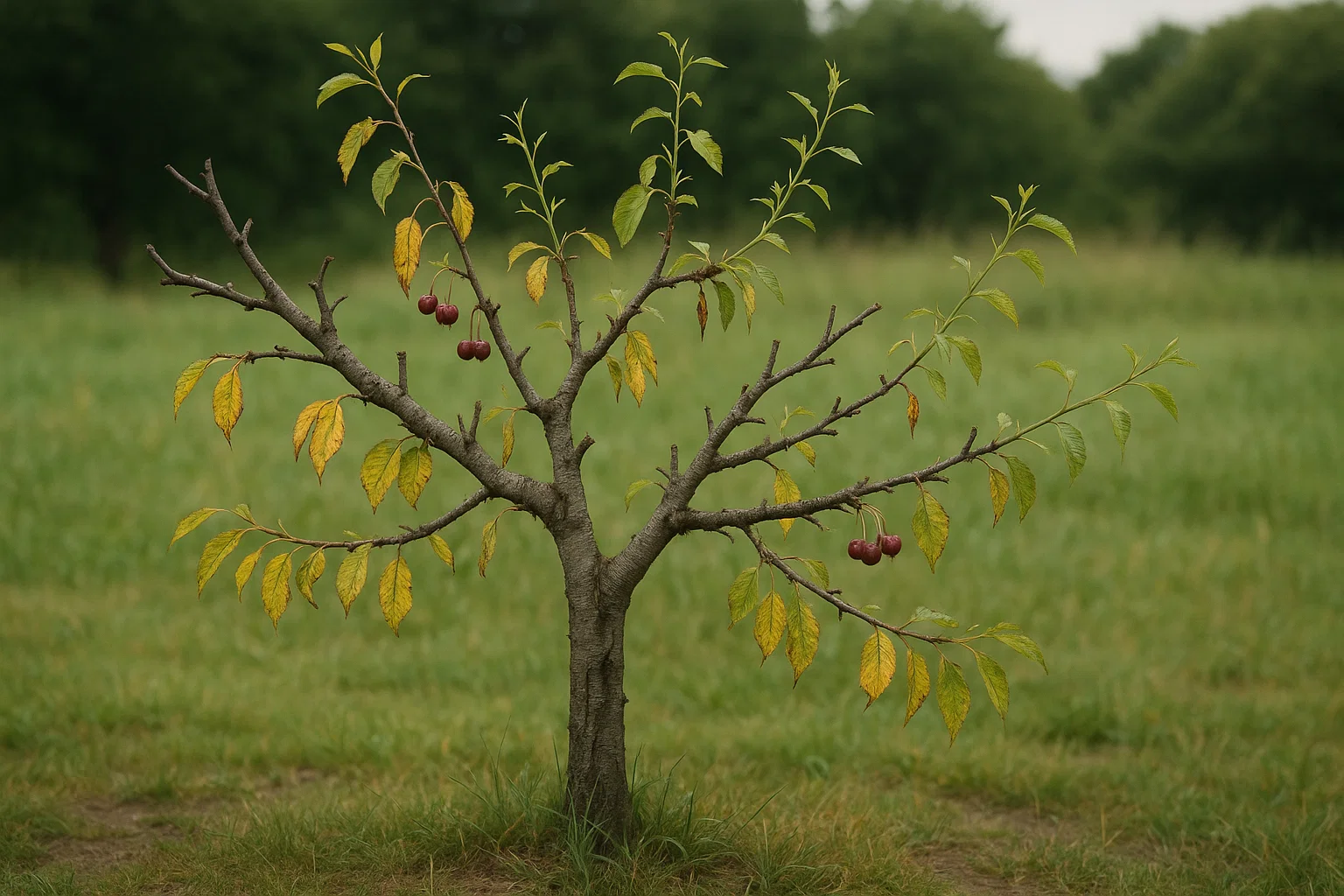
🍃 1. Leaf Loss 🍃
If your tree starts shedding leaves more than usual after pruning, it may be a sign that you’ve removed too much of the tree’s growth. A healthy tree should continue to grow new leaves after pruning without significant leaf drop.
🌱 2. Slow or Stunted Growth 🌱
After pruning, your tree should begin to show signs of new growth. If it’s not sprouting new branches or leaves, it could indicate that you’ve cut away too much of its productive tissue, leaving the tree struggling to recover.
🍒 3. Small, Poor-Quality Fruit 🍒
Excessive pruning can reduce the energy available for fruit production. If your tree begins producing smaller or fewer cherries than usual, it might be due to over-pruning, which has weakened the tree’s ability to bear fruit.
🌿 4. Weak or Spindly New Growth 🌿
New branches should be strong and healthy. If the tree starts producing weak, thin, or spindly growth after pruning, it may indicate that too many vital branches were removed.
😞 5. Tree Appears Stressed 😞
A tree that’s been over-pruned might look generally unhealthy—yellowing leaves, wilting, or slower-than-usual growth can all be signs that the tree is struggling to recover from excessive cutting.
If you notice any of these signs, take a step back and allow your tree time to recover. In the future, prune lightly and carefully to avoid stressing your cherry tree. Regular, moderate pruning is the best approach to maintaining a healthy and productive tree. 🌳🍒
🍒🌳 Pruning Cherry Trees for Maximum Yield 🌳🍒
To get the best fruit production from your cherry tree, proper pruning is essential. Here are some strategies to help you achieve maximum yield while maintaining tree health:
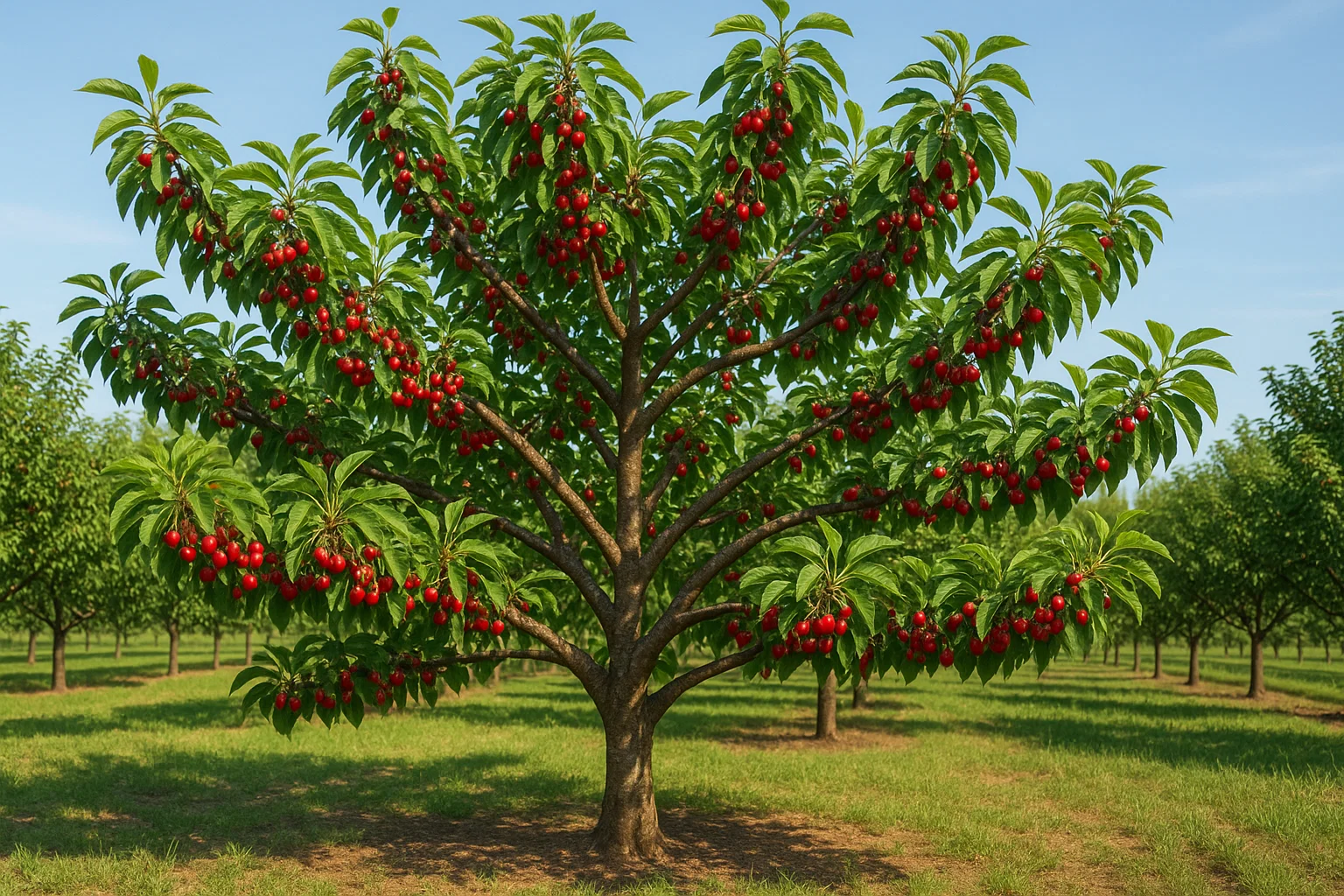
🍇 1. Encourage Strong, Fruit-Bearing Branches 🍇
Focus on pruning to promote branches that are most likely to bear fruit. Look for branches that are strong, well-positioned, and have good sunlight exposure. Thin out weaker branches that may not produce quality fruit.
🌬️ 2. Thin Out the Canopy 🌬️
A well-thinned tree allows for better airflow and sunlight penetration, both of which are critical for healthy fruit production. Remove any crowded or crossing branches, as these reduce the tree’s ability to produce high-quality fruit.
📏 3. Control Tree Height 📏
Keeping your tree at a manageable height ensures that all branches receive enough sunlight and air circulation. Plus, it makes harvesting easier! If the tree gets too tall, prune the leader or top branches to maintain a balanced height.
🌿 4. Remove Suckers and Water Sprouts 🌿
Suckers (growth from the base) and water sprouts (vertical, unproductive shoots) can drain energy from the tree. By cutting them off, the tree can focus its energy on the fruit-bearing branches.
🏗️ 5. Maintain a Strong Structure 🏗️
A cherry tree with a strong, open structure is better able to support its fruit. When pruning, aim for 3-4 main scaffold branches that spread out evenly. This structure allows the tree to hold up heavy cherries and promotes even fruiting.
🍒➡️✂️ 6. Prune After Harvest 🍒➡️✂️
For mature trees, pruning after harvest is an effective way to maintain size and shape while giving the tree time to recover before the next growing season. This timing helps maximize next year’s yield.
By pruning with a focus on these strategies, your cherry tree will have the best chance at producing larger, juicier, and more abundant fruit each season! 🌳🍒
🚫✂️ Common Pruning Mistakes to Avoid ✂️🚫
Pruning can be a delicate task, and even experienced gardeners can make mistakes that impact the health of their cherry trees. Here are some common pruning errors to watch out for:
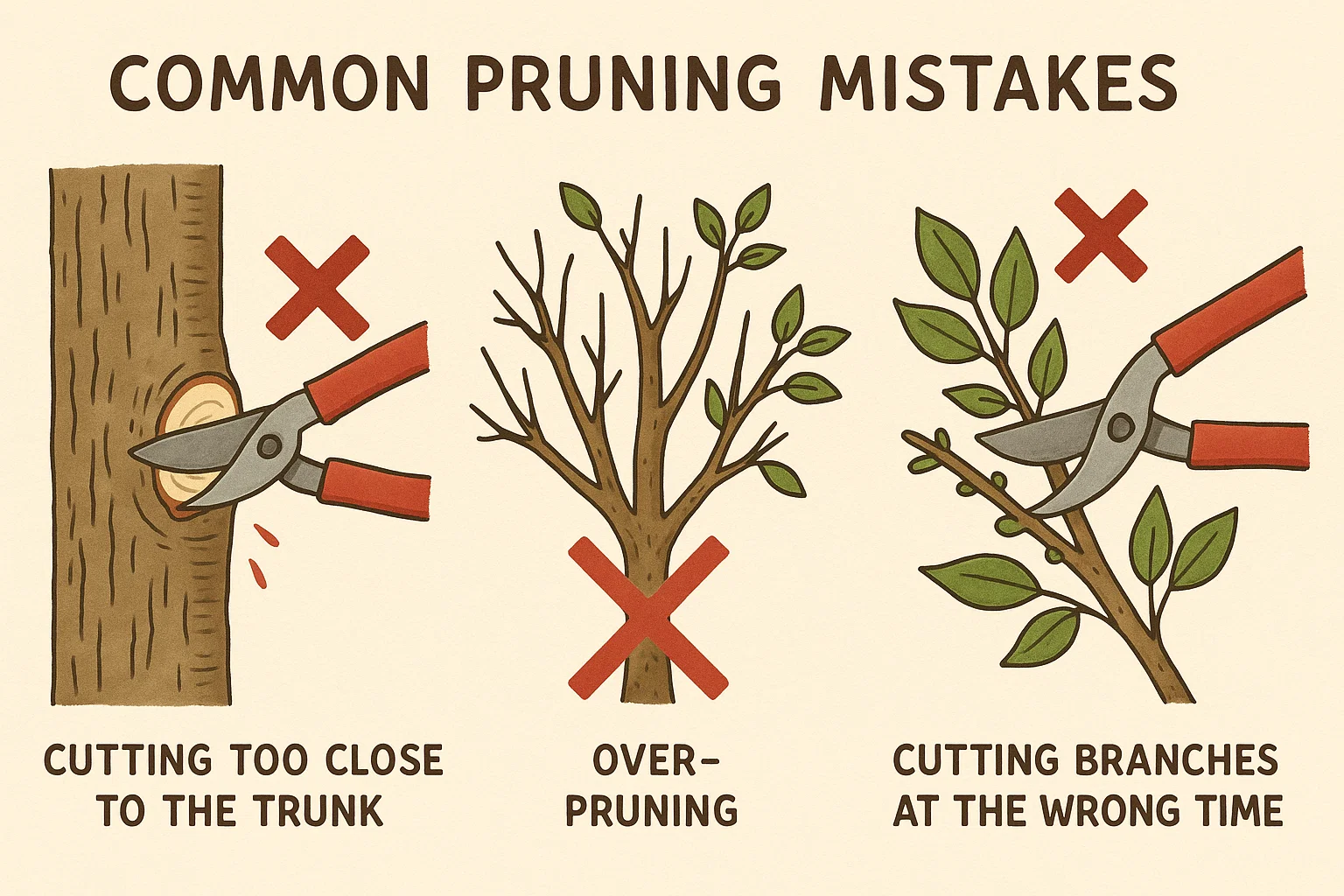
⏰ 1. Pruning at the Wrong Time ⏰
Timing is crucial for cherry tree health. Pruning too late in the season (especially in fall or winter) can expose the tree to frost damage, while pruning too early can interrupt the tree’s natural dormancy. Aim for late winter or early spring, before new growth begins.
⚠️ 2. Over-Pruning ⚠️
Removing too many branches can weaken the tree and reduce fruit production. Avoid cutting away more than 20-30% of the tree’s branches. Too much pruning can also lead to slow regrowth and stress, leaving your tree vulnerable to pests and diseases.
🧴 3. Not Sterilizing Tools 🧴
Failing to disinfect pruning tools between cuts can spread diseases from one branch to another. Always clean your tools with rubbing alcohol or a disinfectant to prevent the transfer of harmful pathogens.
✂️ 4. Cutting Too Close to the Trunk ✂️
When cutting a branch, don’t cut too close to the main trunk or stem. This can damage the tree’s bark and make it more susceptible to disease. Instead, leave a small collar (a raised area where the branch meets the trunk) to help the tree heal.
🌳 5. Ignoring the Tree’s Natural Shape 🌳
Cherry trees have a natural structure that supports healthy growth and fruiting. Pruning in a way that forces the tree into an unnatural shape can cause long-term problems. Focus on shaping the tree to enhance its natural form, rather than trying to make it look like something it’s not.
🧠 6. Pruning Without a Plan 🧠
Going into pruning without a clear idea of what you want to achieve can lead to uneven cuts and poor results. Always take a step back and assess the tree before you start cutting. Prioritize removing unhealthy or overcrowded branches first, then focus on shaping.
🌿 7. Pruning During Active Growth 🌿
Avoid pruning while the tree is actively growing (during the spring and summer months), as this can stress the tree and interfere with its natural growth cycle. Always prune when the tree is dormant for the best results.
By steering clear of these common mistakes, you’ll help your cherry tree stay healthy, productive, and strong year after year! Understanding Cherry Tree Pruning: When and How to Cut for Maximum Yield is key to avoiding these pitfalls. 🌳🍒
🌿🌳 Post-Pruning Care 🌳🌿
After pruning, taking good care of your cherry tree is essential to help it recover and thrive. Here’s how to ensure your tree bounces back quickly and stays healthy:
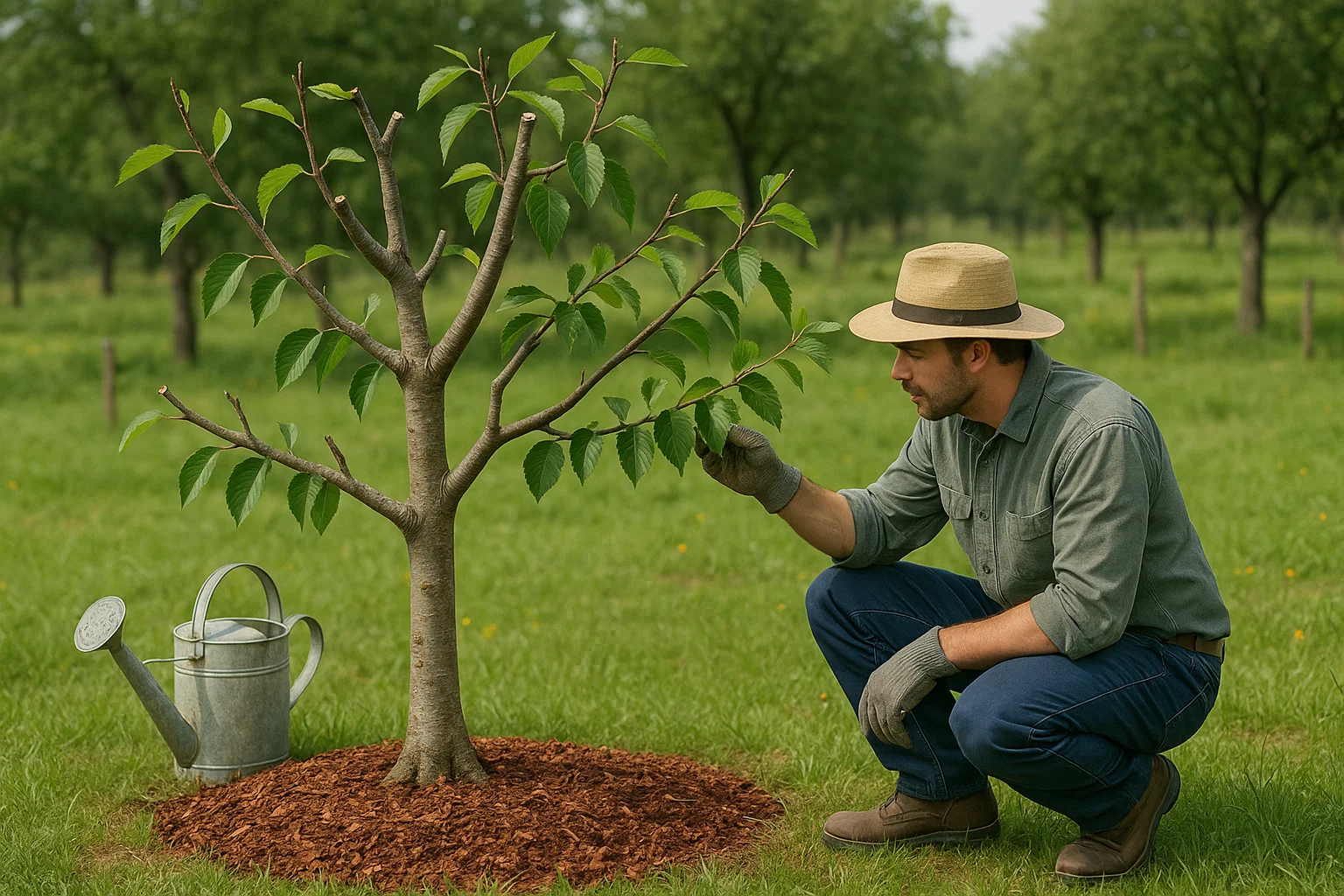
💧 1. Watering 💧
Right after pruning, your tree may need extra hydration to support new growth. Water it deeply to ensure the roots stay moist, but avoid overwatering, as this can lead to root rot. A good rule of thumb is to water thoroughly once a week during dry spells.
🌱 2. Fertilizing 🌱
Pruning stimulates growth, so feeding your cherry tree with a balanced fertilizer can help it recover quickly. Apply a slow-release fertilizer or compost in early spring, just before new growth starts. Avoid over-fertilizing, as this can lead to excessive growth at the expense of fruit production.
🍂 3. Mulching 🍂
Add a layer of mulch around the base of your tree. This helps retain moisture, regulate soil temperature, and suppress weeds. Use organic mulch like wood chips, but keep it a few inches away from the trunk to avoid rot.
🐞🦠 4. Monitor for Pests and Diseases 🦠🐞
After pruning, keep a close eye on your tree for signs of pests or diseases. Open cuts can attract insects, so check regularly for any signs of trouble. Treat any issues immediately with organic or chemical treatments, depending on your preference.
⏳ 5. Be Patient ⏳
Give your tree time to heal and adjust to the pruning. Don’t expect immediate results, but with proper care, it will bounce back stronger. Keep monitoring its growth and ensure it’s getting the right nutrients and environment for optimal recovery.
✂️ 6. Avoid Further Pruning for the Season ✂️
Once you’ve pruned, avoid the temptation to prune more in the same season. Your tree needs time to recover from the cuts you’ve already made. Only prune again in the next dormant season, unless you notice any dead or diseased wood that needs immediate attention.
By following these post-pruning care tips, your cherry tree will recover quickly, stay healthy, and be ready for a bountiful season of fruit! Proper timing and technique are essential for Cherry Tree Pruning: When and How to Cut for Maximum Yield. 🌳🍒
🌳🍒 Final Thoughts 🍒🌳
Pruning your cherry tree is an essential task that requires care, patience, and attention to detail. When done correctly, it not only enhances the tree’s health but also promotes stronger growth and better fruit production. Remember, timing and technique are key—pruning too much or at the wrong time can stress your tree, while proper pruning ensures a healthy, thriving cherry tree that will reward you with a bountiful harvest year after year.

By following the steps outlined in this guide, you’ll be well-equipped to give your cherry tree the care it deserves. Whether you’re a seasoned gardener or a beginner, regular, thoughtful pruning will help your tree flourish, produce juicy cherries, and continue to grow stronger with each season. So, grab your tools, and start pruning with confidence! 🌳🍒
Happy gardening! 🌿
Frequently Asked Questions (FAQ)
When is the best time to prune a cherry tree?
The best time to prune a cherry tree is during late winter or early spring, while the tree is still dormant. This ensures minimal stress on the tree and allows it to heal quickly before the growing season begins.
How often should I prune my cherry tree?
Prune your cherry tree annually to maintain its shape, remove dead or diseased wood, and encourage better airflow. Regular pruning helps improve fruit production and tree health.
What tools do I need for pruning a cherry tree?
For pruning, you’ll need sharp pruning shears for small branches, a pruning saw for larger branches, and loppers for medium-sized branches. Always clean and sterilize your tools to prevent disease transmission.
How do I prune a cherry tree to increase fruit production?
Focus on removing dead, damaged, or crossing branches to improve air circulation and light exposure. Aim to create an open center shape to allow sunlight to reach all parts of the tree. This encourages healthier growth and more fruit production.
Should I prune the cherry tree’s branches back?
Yes, lightly prune back the branches of your cherry tree to maintain a good shape and remove excessive growth. Avoid heavy pruning, as it can reduce fruit production and slow down the tree’s growth.
Can I prune my cherry tree in the summer?
It’s generally not recommended to prune cherry trees in the summer, as it can stress the tree and make it more vulnerable to diseases. Summer pruning should be limited to removing dead or damaged branches.
What are the common mistakes to avoid when pruning cherry trees?
Avoid cutting too much of the tree at once, pruning during the wrong season, and not disinfecting your tools. Over-pruning or improper cuts can harm the tree and reduce fruit yield.
How do I prune a young cherry tree?
For young cherry trees, prune to establish a strong central leader and remove any competing branches. Focus on creating a balanced structure with clear spacing between branches to ensure proper growth and future fruiting.
